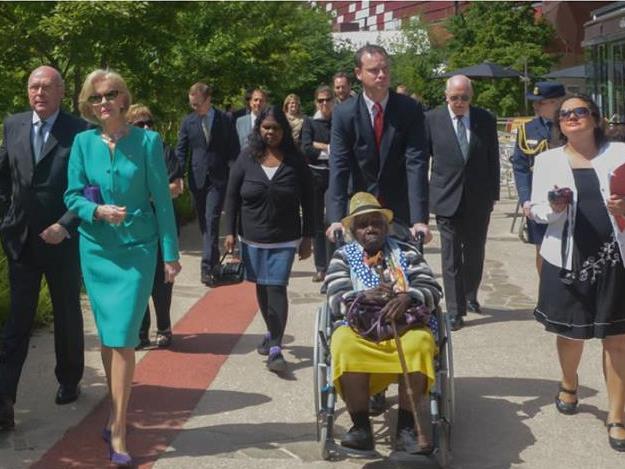Aboriginal Australian artist Lena Nyadbi (in wheelchair) and dignitaries at the opening of the Musée du quai Branly in Paris, which features her work on the roof.
There is a mutual dependency between the arts, business and government. Of course the arts need business and government funding.
But government and business also need the arts to inspire and empower citizens and to stand out in an increasingly competitive and globalised world.
The arts are a significant contributor to Australia’s culture and economy – about $1 billion is generated each year through ticket sales to performance and arts events.
But more than other industries, the value of the arts comes from generating opportunities that flow through to all parts of economy and society.
Finding opportunities, closing deals
Who is always in the first twenty rows of every performance and at the launch of every exhibition? The elite: political, business, community and arts industry identities.
The arts facilitate interaction among the people who make the decisions that affect Australia’s success. Overseas and at home, the diplomatic corps know the power of arts events for greasing the wheels.
Businesses have already recognised the power of the arts to bring highly paid, highly educated professionals into a room and to form important business relationships. Art provides the point of a shared appreciation so necessary to other trade and political negotiations.
The arts also convey a nation’s sophistication, history and tourism appeal channelled via business and trade missions, diplomacy and cultural exchange.
This is word-of-mouth marketing at an über-influential level. When politicians and highly influential people speak eloquently and admiringly about Australia overseas, the impact is far greater than any form of advertising.
Brand Australia
Australia is no longer the nation defined by the Crocodile Dundee years of ‘slip another shrimp on the barbie’. Our population is ethnically diverse with myriad expressions of culture. At community and professional levels, we enjoy a burgeoning arts scene. While globalisation has homogenised culture in the West, it is our unique and original arts organisations that reflect and define Australia’s contemporary culture.
The arts play an important role in shaping Australia’s image.
What do our artists say about us? 21st Century Australia is a country capable of self- analysis – we are not afraid to consider the uncomfortable, the challenging and sometimes appalling aspects of modern life.
We care: about people and nature, and their intersection with the economy. A confident people, we push boundaries, seeking ever better ways of doing things. But we sometimes get it wrong.
With the internet and its search and social media platforms, the arts has unparalleled capacity to define and promote Brand Australia.
Only the arts consistently produce genuinely authentic and original content. It is content that is memorable, shareable and emotive. And that’s what branding is all about.
Competitiveness of Australia’s industries
In today’s global economic climate, organisations must continuously identify social problems and then devise creative solutions to them in order to survive.
Art helps organisations to identify social problems. Artists are the voice of society, bringing, for example, ideas that sprung from a bedroom discussion and a solution that has never been spoken before, to life. Increasing global competition has forced Australia to find new ways to compete. Art has always involved creativity, innovation and alternate forms of thinking – exactly what today’s organisations need.
The economic benefits of being a global cultural nation or capital are well known. You attract the ‘creative class‘. These are the people who develop and commercialise ideas which differentiate a nation in an extremely competitive world. The era of manufacturing as a major job creator is over; our future rests in ideas manifest in new high value products, smarter agricultural production, education and services. That means attracting the very people who value and follow arts organisations.
This, in turn, is what attracts global businesses to invest in Australia. A regional office in Australia means inviting the smartest minds to work hard but enjoy the lifestyle. A highly skilled professional choking on smog in downtown Shanghai chooses Australia because they are in demand. When they arrive they contribute to local business networks and knowledge hubs like universities, and they enrich our understanding of the world they came from.
Arts organisations are invaluable societal and economic assets. The arts need Australia’s support but Australia needs the arts.





